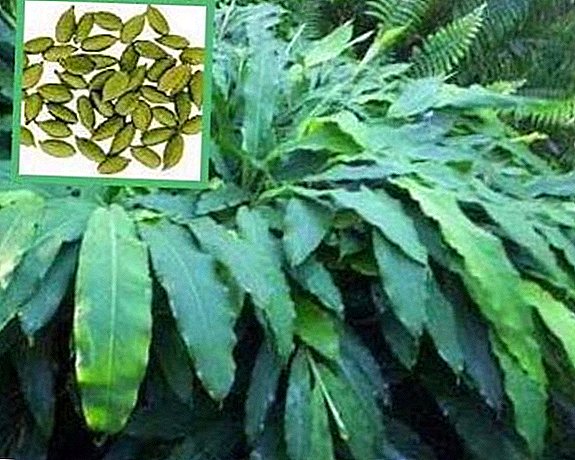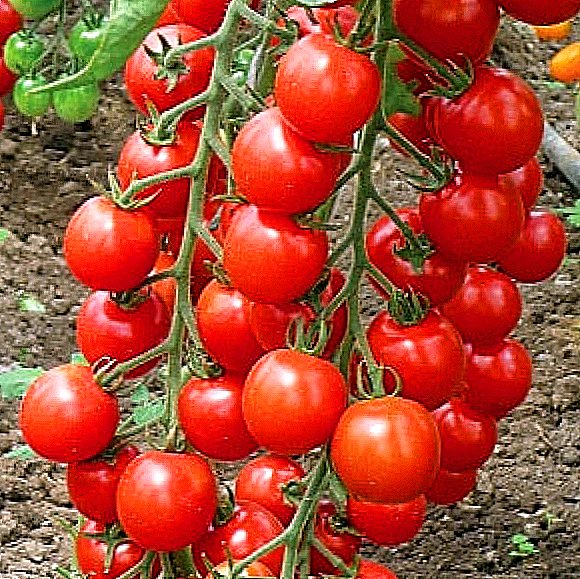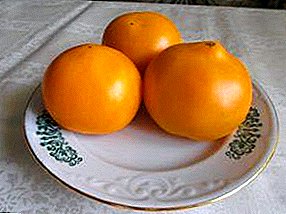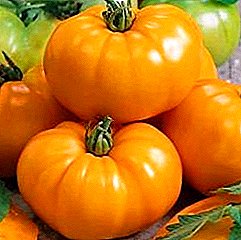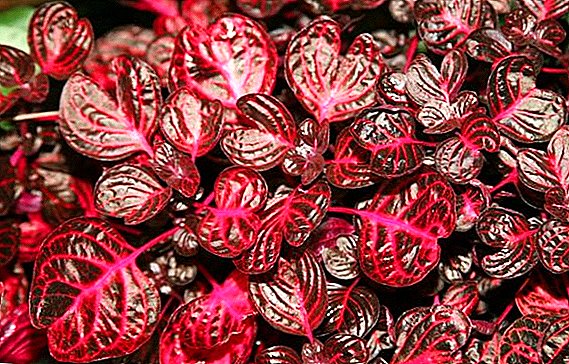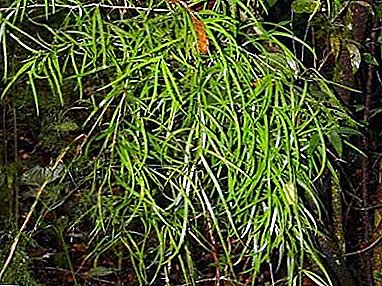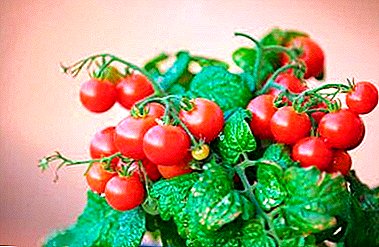
The word "bonsai" in Japan is called miniature trees intended for growing in pots.
Tomatoes Bonsai - one of the most popular varieties of tomatoes, adapted for growing at home.
In our article we will tell you what time of year and where it is best to grow them, how to choose the right soil and pot, as well as how to plant and care in order to get a rich harvest.
Variety description
This variety of tomatoes is bred by domestic breeders. from the company "Gavrish" in the 90s. This agricultural enterprise put on sale quite a few varieties of decorative tomatoes that have found a wide response in the hearts of vegetable lovers and have been in demand for 2 decades already.
The main distinctive feature of the variety is the low growth of the stem (not more than half a meter), early ripeness and significant branching. The average height of a Bonsai grown in an apartment does not exceed 20-30 cm. All this makes the shape of a bush similar to the crown of a tree. Bonsai can be grown both in open ground and on a well-lit balcony or window sill. The plant tolerates a lack of sunlight (moreover, it inhibits the growth of plants in height), but an excess of coverage will better affect its growth and the number of fruits.
 Shrubs Tomato Bonsai valuable rather as a houseplant and unusual interior decoration than how fruit. They are unpretentious to the soil, but demanding of moisture. Bonsai tomatoes are distinguished by small dark green leaves that resemble the foliage of potatoes. Small tomato flowers are discreet in appearance and dim color.
Shrubs Tomato Bonsai valuable rather as a houseplant and unusual interior decoration than how fruit. They are unpretentious to the soil, but demanding of moisture. Bonsai tomatoes are distinguished by small dark green leaves that resemble the foliage of potatoes. Small tomato flowers are discreet in appearance and dim color.
There are several varieties of Bonsai, which have different sizes. One of them - the hybrid variety "Bonsai-Micro F1" reaches a height of only 20 cm, but is not inferior in yield to its higher brothers. Productivity reaches up to 2 kg from one plant. Fruits have a dense structure, small weight and size (up to 30 grams). All fruits ripen at the same time, as on all tomatoes, gradually changing its color from green to bright red.
The period of fruit ripening in Bonsai in some cases can reach several months. Unripe fruits can ripen on the windowsill. Bonsai fruits have excellent taste, good for adding to salads and canning. The rind of the fruit is thin, juicy and smooth, and the flesh is dense, friable, with a high sugar content. Their taste is highly dependent on the amount of sun and the quality of care for the plant. Unfortunately, the fruits of this variety are not stored fresh for a long time.
Where to grow?
Bonsai is far from the most suitable variety for cultivation in open ground due to its poor resistance to temperature extremes and numerous diseases (for example, phytophthora). It is preferable to keep it in room conditions, because this variety was bred for them.
A pot with tomato is preferably placed on a window facing south or southeast. In winter (and in temperate latitudes - all year round), you can compensate for the lack of sun by using fluorescent lamps. Capacities with seedlings should not be constantly turned to the Sun by one side, otherwise they will grow asymmetrical.
Pot and soil
For normal growth potted bonsai will need half a liter of soil per plant. Pots for tomatoes should have holes for drainage, it is desirable to fill their lower part with any drainage (for example, expanded clay). The optimal soil composition is as follows (in descending order of the volume of the components):
- soil rich in humus;
- peat;
- washed and disinfected river sand;
- ash trees.
Landing
 If the seeds of Bonsai are acquired from strangers with hands or cause other suspicions, they should be disinfected before planting. It is possible to facilitate the germination of seeds, having previously sustained them for 2 days, wrapped in a cloth moistened with water or gauze.
If the seeds of Bonsai are acquired from strangers with hands or cause other suspicions, they should be disinfected before planting. It is possible to facilitate the germination of seeds, having previously sustained them for 2 days, wrapped in a cloth moistened with water or gauze.
Some companies that produce seeds under their trademarks, before packaging, process them with substances that contribute to the death of pathogens and accelerate germination. Such seeds can be distinguished by a color that is different from the natural light beige.
When planting tomatoes in open ground, it is recommended to plant them in small plastic cups in March, and only 2 months later transplanted into the ground. If frost occurs in your latitudes, be sure to cover the young tomatoes with foil. The optimal place for growing tomatoes Bonsai should be well lit and protected from the winds from the north.
The soil in the tanks in which the seeds are planted should be slightly damp. It is recommended to moisten it evenly in advance - 2-3 days before planting, using a spray bottle.
Seeds are planted to a depth of 1 cm. If done correctly, the first shoots make their way to the surface about a week after planting. It is recommended to plant 2-3 seeds per one small container and subsequently leave only 1 - the strongest sprout in it. When planting in open ground on 1 square. m beds should be planted no more than 3 bushes.
Care
The required frequency of watering an adult tomato is about 1 time per week, in hot weather, it is desirable to increase it to 2-3 times. Water only with warm water at room temperature. The leaves of a young plant is useful to spray. Yellowing of the leaves or the formation of mold can signal an excess of moisture in the soil.
The growing tomato bush needs to be supplemented with fertilizers with a high nitrogen content, and during the fruit ripening period - calcium. The first fertilization can be done 2 weeks after the sprouts appear, the last one a week before transplanting to the pot / open ground.
 Bonsai variety does not need pruning. To increase the yield it is useful to pinch the tops of the bushes before flowering. Experienced gardeners also resort to tearing up tomato root processes in order to stimulate its growth. To do this, take the stalk at its base and slightly pull it up. This should be done with care so as not to damage the large roots.
Bonsai variety does not need pruning. To increase the yield it is useful to pinch the tops of the bushes before flowering. Experienced gardeners also resort to tearing up tomato root processes in order to stimulate its growth. To do this, take the stalk at its base and slightly pull it up. This should be done with care so as not to damage the large roots.
Seeds sprout quickly and at the same time. Seeds of Bonsai usually germinate very quickly and amicably. If the boxes with seedlings are constantly lit (you need to use additional fluorescent lighting), then the first sprouts appear in the first week. At the age of two months, tomatoes will bloom and perhaps even the first buds of plants will appear. The more sun will fall on the bushes, the better their growth will be and the sweeter the fruits. In shaded conditions, tomatoes lose their taste and juice.
The plant has flowers of both sexes and is capable of self-pollination. In order to stimulate pollination, you can shake branches with flowers before watering the plants.
Often To the cultivation of tomatoes in the apartment are just as an interesting experiment. However, the experience of cultivating such a whimsical culture, like a Bonsai tomato, can only be successful if you take the cultivation of decorative tomatoes with full responsibility. Otherwise, you only waste your precious time and nerves.


